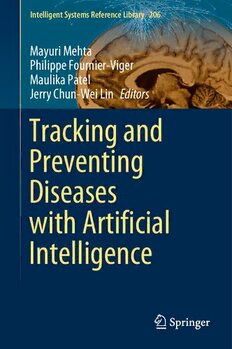Table Of ContentIntelligent Systems Reference Library 206
Mayuri Mehta
Philippe Fournier-Viger
Maulika Patel
Jerry Chun-Wei Lin Editors
Tracking and
Preventing
Diseases
with Artificial
Intelligence
Intelligent Systems Reference Library
Volume 206
SeriesEditors
JanuszKacprzyk,PolishAcademyofSciences,Warsaw,Poland
LakhmiC.Jain,KESInternational,Shoreham-by-Sea,UK
The aim of this series is to publish a Reference Library, including novel advances
and developments in all aspects of Intelligent Systems in an easily accessible and
wellstructuredform.Theseriesincludesreferenceworks,handbooks,compendia,
textbooks,well-structuredmonographs,dictionaries,andencyclopedias.Itcontains
wellintegratedknowledgeandcurrentinformationinthefieldofIntelligentSystems.
Theseriescoversthetheory,applications,anddesignmethodsofIntelligentSystems.
Virtuallyalldisciplinessuchasengineering,computerscience,avionics,business,
e-commerce,environment,healthcare,physicsandlifescienceareincluded.Thelist
oftopicsspansalltheareasofmodernintelligentsystemssuchas:Ambientintelli-
gence,Computationalintelligence,Socialintelligence,Computationalneuroscience,
Artificiallife,Virtualsociety,Cognitivesystems,DNAandimmunity-basedsystems,
e-Learningandteaching,Human-centredcomputingandMachineethics,Intelligent
control,Intelligentdataanalysis,Knowledge-basedparadigms,Knowledgemanage-
ment, Intelligent agents, Intelligent decision making, Intelligent network security,
Interactive entertainment, Learning paradigms, Recommender systems, Robotics
and Mechatronics including human-machine teaming, Self-organizing and adap-
tive systems, Soft computing including Neural systems, Fuzzy systems, Evolu-
tionarycomputingandtheFusionoftheseparadigms,PerceptionandVision,Web
intelligenceandMultimedia.
IndexedbySCOPUS,DBLP,zbMATH,SCImago.
AllbookspublishedintheseriesaresubmittedforconsiderationinWebofScience.
Moreinformationaboutthisseriesathttp://www.springer.com/series/8578
· ·
Mayuri Mehta Philippe Fournier-Viger
·
Maulika Patel Jerry Chun-Wei Lin
Editors
Tracking and Preventing
Diseases with Artificial
Intelligence
Editors
MayuriMehta PhilippeFournier-Viger
DepartmentofComputerEngineering SchoolofHumanitiesandSocialSciences
SarvajanikCollegeofEngineering HarbinInstituteofTechnology(Shenzhen)
andTechnology Shenzhen,Guangdong,China
Surat,Gujarat,India
JerryChun-WeiLin
MaulikaPatel DepartmentofComputerScience,
DepartmentofComputerEngineering ElectricalEngineeringand
G.H.PatelCollegeofEngineering MathematicalSciences
andTechnology WesternNorwayUniversityof
CharutarVidyaMandalUniversity AppliedSciences
VallabhVidyanagar,Gujarat,India Bergen,Norway
ISSN1868-4394 ISSN1868-4408 (electronic)
IntelligentSystemsReferenceLibrary
ISBN978-3-030-76731-0 ISBN978-3-030-76732-7 (eBook)
https://doi.org/10.1007/978-3-030-76732-7
©TheEditor(s)(ifapplicable)andTheAuthor(s),underexclusivelicensetoSpringerNature
SwitzerlandAG2022
Thisworkissubjecttocopyright.AllrightsaresolelyandexclusivelylicensedbythePublisher,whether
thewholeorpartofthematerialisconcerned,specificallytherightsoftranslation,reprinting,reuse
ofillustrations,recitation,broadcasting,reproductiononmicrofilmsorinanyotherphysicalway,and
transmissionorinformationstorageandretrieval,electronicadaptation,computersoftware,orbysimilar
ordissimilarmethodologynowknownorhereafterdeveloped.
Theuseofgeneraldescriptivenames,registerednames,trademarks,servicemarks,etc.inthispublication
doesnotimply,evenintheabsenceofaspecificstatement,thatsuchnamesareexemptfromtherelevant
protectivelawsandregulationsandthereforefreeforgeneraluse.
Thepublisher,theauthorsandtheeditorsaresafetoassumethattheadviceandinformationinthisbook
arebelievedtobetrueandaccurateatthedateofpublication.Neitherthepublishernortheauthorsor
theeditorsgiveawarranty,expressedorimplied,withrespecttothematerialcontainedhereinorforany
errorsoromissionsthatmayhavebeenmade.Thepublisherremainsneutralwithregardtojurisdictional
claimsinpublishedmapsandinstitutionalaffiliations.
ThisSpringerimprintispublishedbytheregisteredcompanySpringerNatureSwitzerlandAG
Theregisteredcompanyaddressis:Gewerbestrasse11,6330Cham,Switzerland
Preface
Allaroundtheworld,thespreadofinfectiousdiseasesisamajorconcernasitdirectly
impactsthehealthofpeople.Whilesomeinfectiousdiseasesmayhaveaminorimpact
onsociety,somecanhavemajorimpactssuchastherecentSARS-CoV-2coronavirus
pandemic,alsoknownasCOVID-19.
To cope with the spread of infectious diseases, some traditional approaches are
usedsuchastostudytheeffectofmedicinesanddevelopnewones,designappropriate
vaccines,andenforcevariousmeasuressuchaswashinghands,wearingfacemasks,
and doing temperature checks. However, despite the usage of such measures and
medicaladvancements,thereremainseveralincurablediseasesforwhichprevention
istheonlycure.Besides,timeisoftencriticalwhencopingwithnewdiseasesthat
arehighlycontagioussuchasCOVID-19asnovaccineorveryeffectivemedicineis
initiallyavailable.
Tocopewiththesechallenges,artificialintelligence(AI)hasbeenrapidlyadopted
to assist physicians in diagnosis, disease tracking, prevention, and control. Due to
increasingtheavailabilityofelectronichealthcaredataandrapidprogressofanalytics
techniques, a lot of research is being carried out in this area by applying machine
learninganddataminingtechniquestoassistthemedicalprofessionalsformaking
apreliminaryevaluation.
Thisbookisacollectionof11chaptersthatprovidesatimelyoverviewofrecent
advancesinthisarea,thatis,touseartificialintelligencetechniquesfortrackingand
preventing diseases. The target audience of this book is researchers, practitioners,
andstudents.Abriefdescriptionofeachchapterisgivenbelow.
InChap.1,fourapproachestoidentifystressbyrecognizingtheemotionalstate
of a person have been proposed. Pradeep et al. have analyzed the performance of
theproposedapproaches usingSurreyAudio-VisualExpressedEmotion(SAVEE)
and ENTERFACE databases. The results illustrate the considerable reduction in
computationaltimeandshowthatvectorquantization-basedfeaturesperformbetter
thanmel-frequencycepstralcoefficientsfeature.
In Chap. 2, Fayemiwo et al. compared various approaches for the detection of
COVID-19fromX-rayimages.Theproblemisviewedasaclassificationproblem
withtwoclasses(normalvsCOVID-19)orthreeclasses(normal,pneumonia,and
COVID-19).Afine-tunedVGG-19convolutionalneuralnetworkwithdeeptransfer
v
vi Preface
learningshowsthathighaccuracycanbeobtained(from89%to99%dependingon
thescenario.
In Chap. 3, Falguni et al. aim to develop an intelligent diagnostic system for
glaucoma—an eye-related disease, from the data obtained through clinicians by
variousexaminationdevicesorequipmentusedinophthalmology.Theclassification
is done by using a hybrid approach using artificial neural network, Naïve Bayes
algorithms, decision tree algorithms, and 18 medical examination parameters for
a patient. FGLAUC-99 is developed with J48, Naïve Bayes, and MLP classifiers
withaccuracyof99.18%.Theaccuracyisnotcomparedwithotherclassifiersasthe
datasetisexclusivelydeveloped.
InChap.4,Pathaketal.haveintroducedtwoapproaches,onebasedonasimple
neural network and another based on a deep convolutional neural network, for
diagnosis of tuberculosis disease. To evaluate the performance of the proposed
approaches, they conducted experiments using tuberculosis chest X-ray dataset
availableonKaggleandreceivedclassificationaccuracyof99.24%.
InChap.5,SarumiandLeungproposedanadaptiveNaiveBayes-basedmachine
learning algorithm for efficient prediction of genes in the genome of eukaryotic
organisms. The adaptive Naive Bayes algorithm provided a sensitivity, specificity,
and accuracy of 81.52%, 94.01%, and 96.02%, respectively, on discovering the
protein-codinggenesfromthehumangenomechromosomeGRCh37.
In Chap. 6, Deshpande et al. presented a survey work on different areas where
microscopic imaging of blood cells is used for disease detection. A small note on
bloodcompositionisfirstdiscussed,whichisfollowedbyageneralizedmethodology
for microscopic blood image analysis for certain application of medical imaging.
Several models using microscopic blood cell image analysis are also summarized
fordiseasedetection.
In Chap. 7, Mahajan and Rana presented a comprehensive review of the recent
clinicalnamedentityclassificationusingrule-based,deeplearning-based,andhybrid
approaches.Theefficacyofclinicalnamedentityrecognition(NER)techniquesfor
informationextractionisalsodiscussedandseveralexperimentsarethenevaluated
toshowthestate-of-the-artmodelswithhighaccuracybycombiningdeeplearning
(DL)modelswithasequentialmodel.
In Chap. 8, the topic of disease diagnosis from CT scan images is discussed.
Sajja et al. present a generic and hybrid intelligent architecture for disease diag-
nosis. The architecture can classify images into various disease categories using a
convolutional neural network and is applied for detecting the COVID-19 disease.
Thedesignofthemodelispresentedindetailwithanexperimentalevaluationand
adiscussionofapplicationsforotherdiseasediagnosesusingradiologyimages,as
wellaspossibilitiesforfuturework.
InChap.9,skinlesionclassificationproblemisaddressed.Rocketal.developed
an online system to assist doctors to quickly diagnose skin disease through skin
lesionobservation.Resultsdemonstrate78%testingaccuracyand84%trainingand
validationaccuracy.
InChap.10,Ozaetal.havediscussedvariousmammogramclassificationtech-
niquesthatarecategorizedbasedonfunction,probability,rule,andsimilarity.They
Preface vii
havepresentedcomparativeanalysisofthesetechniquesincludingstrengths,draw-
backs,andchallenges.Afewmechanismstodealwiththesechallengeshavebeen
described.Inaddition,somepubliclyavailablemammogramdatasetsarediscussed
inthischapter.
InChap.11,Sachdevetal.havepresentedthestate-of-the-artsimilarity-basedand
feature-based chemogenomic techniques for the prediction of interaction between
drugcompoundsandproteins.Theyhaveillustratedcomparisonofthesetechniques
includingtheirmeritsanddemerits.
Surat,India MayuriMehta
Shenzhen,China PhilippeFournier-Viger
VallabhVidyanagar,India MaulikaPatel
Bergen,Norway JerryChun-WeiLin
March2021
Contents
1 StressIdentificationfromSpeechUsingClusteringTechniques .... 1
PradeepTiwariandA.D.Darji
2 ComparativeStudyandDetectionofCOVID-19andRelated
ViralPneumoniaUsingFine-TunedDeepTransferLearning ...... 19
MichaelA.Fayemiwo, ToluwaseA.Olowookere,
SamsonA.Arekete, AdewaleO.Ogunde, MbaO.Odim,
BosedeO.Oguntunde, OluwabunmiO.Olaniyan,
TheresaO.Ojewumi,andIdowuS.Oyetade
3 PredictingGlaucomaDiagnosisUsingAI ........................ 51
FalguniRanadive,AkilZ.Surti,andHemantPatel
4 DiagnosisandAnalysisofTuberculosisDiseaseUsingSimple
Neural Network and Deep Learning Approach for Chest
X-RayImages ................................................. 77
KetkiC.Pathak, SwathiS.Kundaram, JigneshN.Sarvaiya,
andA.D.Darji
5 AdaptiveMachineLearningAlgorithmandAnalyticsofBig
GenomicDataforGenePrediction .............................. 103
OluwafemiA.SarumiandCarsonK.Leung
6 MicroscopicAnalysisofBloodCellsforDiseaseDetection:
AReview ..................................................... 125
NilkanthMukundDeshpande, ShilpaShaileshGite,
andRajanikanthAluvalu
7 InvestigatingClinicalNamedEntityRecognitionApproaches
forInformationExtractionfromEMR .......................... 153
PranitaMahajanandDiptiRana
ix
x Contents
8 Application of Fuzzy Convolutional Neural Network
forDiseaseDiagnosis:ACaseofCovid-19DiagnosisThrough
CTScannedLungImages ...................................... 177
PritiSrinivasSajja
9 ComputerAidedSkinDisease(CASD)ClassificationUsing
MachineLearningTechniquesforiOSPlatform .................. 201
C.AlvinoRock, E.BijolinEdwin, C.Arvinthan,
B.KevinJosephPaul,RichardJayaraj,andR.J.S.JebaKumar
10 A Comprehensive Study of Mammogram Classification
Techniques ................................................... 217
ParitaOza,YashShah,andMarshaVegda
11 AComparativeDiscussionofSimilarityBasedTechniques
andFeatureBasedTechniques forInteractionPrediction
ofDrugsandTargets .......................................... 239
KanicaSachdevandManojK.Gupta

